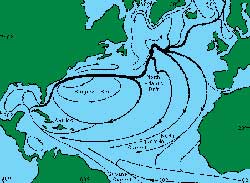Will the Gulf Stream, the warm water current from the Gulf of Mexico across the Atlantic Ocean to Europe, disappear? Scientists are increasingly worried. This ocean current helps regions along the ocean in Europe remain warmer, but it has weakened. This is a consequence of global warming. Melting ice is also disrupting a long-standing balance in the system.
 |
|
The path of the Gulf Stream current |
Paris, the capital of France, under a thick layer of snow. This rare and striking image may become commonplace in winters for decades to come.
A heavy layer of snow each year is no less than what is seen across the Atlantic, in Canada or the United States. France lies at the same latitude as these countries, but like the rest of Europe, it benefits from the favorable conditions provided by the Gulf Stream. The Gulf Stream is a powerful warm water current flowing from the equator northward, seasonally along the southern half of the American coast, then crossing the Atlantic to reach the European coast.
This massive ocean heating system allows Europe to enjoy milder temperatures. As it reaches cooler waters, the Gulf Stream sinks to a depth of 5,000 meters to return to the equator. The issue is that this current is showing unusual signs. Thanks to buoys placed throughout the ocean, British scientists have recorded a 30% decrease in the flow of the Gulf Stream over the past 50 years.
According to some scientists, the weakening of the Gulf Stream is due to the ongoing global warming. With warmer and less salty water in Europe due to melting ice in the North, the Gulf Stream’s activity will be disrupted, similar to its impact on the climate in Europe.
Some believe that initially, the Gulf Stream may partially offset the warming climate in Europe. However, around 100 years from now, colder waters could dominate, plunging Europe into a new ice age.

















































